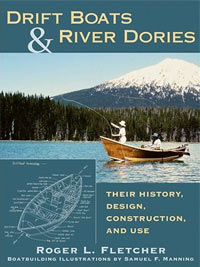| Drift
Boats & River Dories:
Their History, Design, Construction, and Use
by Rodger L. Fletcher (Author), Samuel F. Manning
(Illustrator)
Stackpole Books; 1st edition (July 10, 2007)
 Drift
Boats are rather unique and unless you’re from
the Northwestern United States or an avid fly fisherman
the chances are fairly good that you haven’t
heard of them. Well, you might have seen the ads for
drift boats in the back of WoodenBoat or other boat
building magazines but that’s about it. Drift
Boats are rather unique and unless you’re from
the Northwestern United States or an avid fly fisherman
the chances are fairly good that you haven’t
heard of them. Well, you might have seen the ads for
drift boats in the back of WoodenBoat or other boat
building magazines but that’s about it.
These are boats built for a special purpose, they
are designed to do one thing and do it well. So, unlike
the East Coast dories that have a broader range of
appeal and use, drift boats have pretty much remained
in the Northwest. There are some exceptions to this
because fly fisherman have imported these fine boats
to rivers in other parts of the country.
I first became acquainted with drift boats in 1997
when I was asked to design a multi-chined drift boat
for Larry Sunderland, the owner of The Austin Angler
(The Austin Angler was a nationally known fly fishing
shop in Austin, Texas) and I’ve been fond of
drift boats ever since.
However, you don’t have to fly fish or be
fond of drift boats to enjoy Roger Fletcher’s
Drift Boats and River Dories published by Stackpole
Books. In fact, I’m not sure you’d even
have to be generally interested in boats to enjoy
this book. That might be stretching it a bit but I
really liked this book.
I think what I liked most was the way Fletcher details
how the boats evolved as they moved from the McKenzie
to the Rogue and other rivers in Oregon. Fletcher’s
background as a historian is evident in his careful
documentation as he follows the evolution of the drift
boat and how the character of each river changed the
boat.
But these boats didn’t evolve on their own;
it was the men and sometimes women that rowed them,
that thought about the way the boats interacted with
the river and then changed the boats to meet the demands
of the river. These are the people Fletcher introduces
the reader to with a cohesive narrative, a large number
of photographs, interviews and quotes. That was one
of my favorite aspects of this book. I found I was
as interested in the people and their lives as I was
in the drift boats.
The people’s lives, the history, and the development
of the drift boat is in the first part of the book
and the second part of the book is the how-to-build
a drift boat section. If you want to build a classic
drift boat then here is where you can find that information.
The offsets, the construction plans, and everything
else you’ll need are all there and it’s
all very clearly illustrated by Samuel Manning.
I wouldn’t choose to use those particular
construction techniques but that is a personal choice
and doesn’t mean the methods in the book aren’t
a perfectly fine way to build a boat. After all, that’s
the way the original boats were built so you couldn’t
go wrong building that way.
Even if you plan to build another type of drift
boat or build a drift boat from a kit there is a wealth
of information in the second part of the book. The
details on the rope seats are especially good.
It’s all there from the sliding rope seats
to the Rapid Robert, the double enders, the classic
Rogue River Dory and the rest. This book is a must
have for anyone that knows drift boats or thinks they
might like to learn about these fine boats.

|